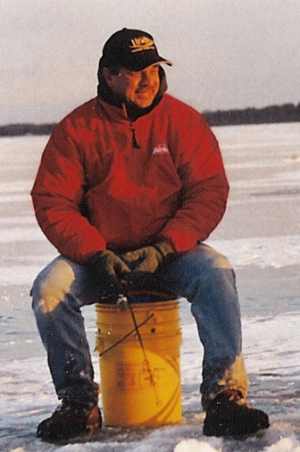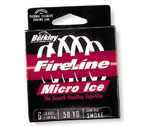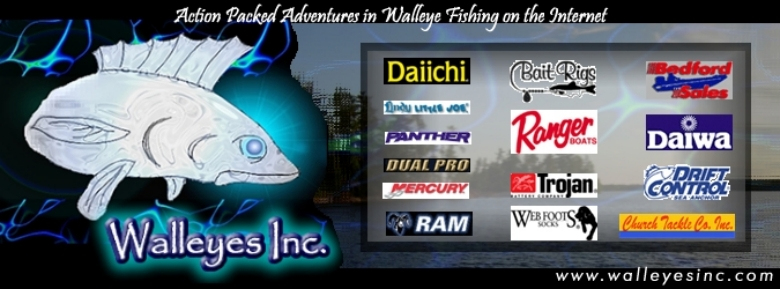| Editor's note: John Kolinski is the 2002 Professional Walleye
Trail Angler of the Year, last year's Illinois River RCL winner
and a 15-time championship qualifier on the PWT, RCL and Masters
Walleye Circuit. His articles can be read in numerous Midwestern
outdoor publications and at several web sites. Kolinski is sponsored
by Triton Boats, Mercury Motors, Lowrance Electronics, Normark/Storm
Lures, MinnKota, Lindy Legendary Tackle, Flambeau, Tempress
Rod Holders, Off-Shore Planer Boards, Berkley Trilene, Optima
Batteries and Panther Marine. |
|
Pick up a February edition of an outdoor magazine
or newsletter and you'll probably see article after article
promising to reveal the secrets to catching crappies the size
of hubcaps, football- shaped perch and bluegills that look
like nuclear experiments. Hard-water fish make great headlines,
and they become more accessible to a greater number of anglers
when a cover of ice locks down our lakes and reservoirs for
the winter. Whether or not you catch fish like those that
take up entire magazine covers, the possibility is often enough
to keep the pursuit alive. You will be lured by hot bites
on lakes both large and small. You'll be intrigued by small
ponds that give up big catches. You'll be motivated by innovative
techniques that take fish from frozen reservoirs. One thing
current events don't always do is go with the flow. River
walleyes are largely overlooked once winter caps the open-water
adventures for all but a handful of die-hards who are willing
to push their boats across the ice to reach the open water
below locks and dams. That doesn't mean there aren't excellent
river-fishing options through the ice. The window of opportunity
is much smaller, but the rewards can be all an eight-inch
auger hole can handle. Not every winter provides access to
moving water.
 |
Even though flows tend to be slower because of lower
water levels in most rivers at this time of year, it takes
some serious cold weather to build a sheet of ice thick
enough for me to venture onto it. Safety is always priority
one. Avoid areas where the river bends or eddies because
changes in current velocity create unstable and unpredictable
ice. Generally speaking, river fishing on the main channel
means working the deep edges of breaklines and sandbars.
Most of the time, I know where to find these areas from
my open-water adventures. Seek out long, straight stretches
of river and test the thickness with your auger as you
cross it. Once I am confident there is sufficient ice
where I want to fish, I drill a number of holes in a relatively
small area along the break, and that's where I fish. Unlike
fishing on lakes and reservoirs where anglers can move
around at will, safe river fishing means limited mobility.
It can be beneficial to drill those holes at a slight
downstream angle. With the current working with them,
it can be difficult to get a 3- to 4-pound walleye's head
started up a standard vertical hole. A slight angle can
make that task much easier. Quality electronics are critical
to success. |
First, it's been my experience that the bottom
edge of the breaklines will produce the most consistent action,
and my Lowrance X-67C Ice Machine gets me on the spots. It's
also important to know there are fish holding on the break
or working along it, and the X-67C lets me know exactly what's
going on in the underwater world so I can focus my efforts
where there seems to be the most activity. One thing I like
about river fishing is its simplicity. Where state regulations
allow multiple lines, I'll rig tip-ups Wolf River-style with
whatever the preferred forage is on the river I'm fishing
(shiners, fatheads, etc.).
|

Berkley
Fire Line Micro Ice
|
The basic rig consists of 8-pound Berkley
Micro Ice, which is a small-diameter, low-stretch, low-
visibility line. Slide a 4-foot leader with your hook
on one end and a barrel swivel on the other up the line.
Then tie another barrel swivel to the end of the line,
followed by a two-foot dropper to which you will attach
as heavy a sinker as is required to take your rig to the
bottom and keep it there in the current. When the sinker
hits bottom, keep the line tight and set the flag. The
sliding leader allows the bait to act naturally and the
fish to eat it without feeling the weight of the sinker,
but yet there is enough tension to easily trip the flag
into free-spool mode. Occasionally, the current will roll
the sinker an inch or two and trip the flag, but that's
simply a fact of life when you go with the flow. |
Lindy
Little Joe Rattlr Spoon
|
You'll also need to check your rigs periodically
for debris. Once I've set as many of those rigs as the
law allows, I move around and put a Lindy Rattl'r jigging
spoon to work or a Lindy Fat Boy jig tipped with a minnow
or shiner. If I have any doubt about the strength of the
ice on the main river, I simply relocate to sloughs off
the main channel where the flow is lighter and ice tends
to be thicker and more uniform. There can be some great
bites in these areas, too. Usually, they can be found
near the mouth of the slough where it meets up with the
main channel. Focus on the upstream edge where walleyes
tend to tuck just around the corner out of the main flow.
Taking care of your live bait and keeping your lures dry
are two important considerations whenever you are fishing
on the ice. Flambeau Outdoors takes care of both areas
with air-tight tackle storage boxes and bait containers
that keep minnows fresh and lively. Going with the flow
is a great mid-winter alternative. Stay abreast of current
events. There are plenty of headlines just waiting to
be written. |
|
|
Please Check Out these links
below to our site Sponsors
|
|

